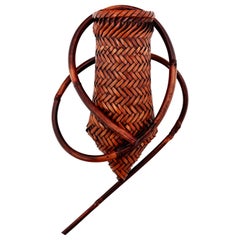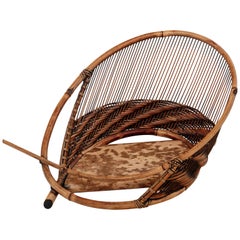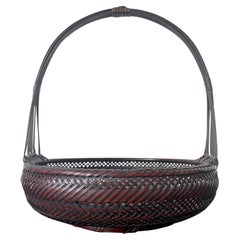Honma Kazuaki
Early 2000s Japanese Organic Modern Sculptures and Carvings
Bamboo
Early 2000s Japanese Organic Modern Sculptures and Carvings
Bamboo
People Also Browsed
Vintage 1930s Japanese Scholar's Objects
Bamboo
Early 20th Century Japanese Japonisme Sculptures and Carvings
Bamboo
Vintage 1920s Japanese Japonisme Sculptures and Carvings
Bamboo
Early 20th Century Japanese Japonisme Sculptures and Carvings
Bamboo
20th Century Japanese Japonisme Decorative Baskets
Bamboo, Rattan
21st Century and Contemporary Japanese Organic Modern Sculptures and Car...
Bamboo, Rattan
Early 2000s Japanese Organic Modern Sculptures and Carvings
Bamboo, Rattan
Early 2000s Japanese Organic Modern Sculptures and Carvings
Bamboo
Early 2000s Japanese Organic Modern Sculptures and Carvings
Bamboo
Early 20th Century Japanese Japonisme Sculptures and Carvings
Bamboo
Early 2000s Japanese Organic Modern Sculptures and Carvings
Bamboo
Early 2000s Japanese Modern Sculptures and Carvings
Bamboo, Rattan
20th Century Japanese Modern Sculptures and Carvings
Bamboo
Early 2000s Japanese Modern Sculptures and Carvings
Bamboo, Rattan
Vintage 1920s Japanese Japonisme Decorative Baskets
Bamboo
Early 2000s Japanese Organic Modern Sculptures and Carvings
Bamboo, Rattan
A Close Look at organic-modern Furniture
Organic modern furniture is characterized by clean lines, an overall uncomplicated aesthetic and a prioritizing of natural, sustainable materials, such as wood and stone. There are lots of earth tones and natural-world textures rather than bright color palettes or fabrics embellished with busy patterns.
Organic furniture is minimalist and, owing to the ideas of venerable architect Frank Lloyd Wright, designed for warm spaces that promote harmony between human habitation and the great outdoors. Organic modern design, including in furniture and architecture, emerged in the 1930s.
Designers such as Andrianna Shamaris, Alguacil & Perkoff and Jörg Pietschmann — all known for organic modern design — have created furniture that brings dynamic and unpredictable energy to home interiors while emphasizing the importance of a relationship with the natural world.
Striking an appealing balance between our living spaces and nature doesn't have to be an arduous task — the broad selection of original organic modern furniture on 1stDibs includes solid wood tables, bamboo seating options, hand-knotted wall tapestries and more.
Materials: bamboo Furniture
Bamboo — the reed-like, woody grass revered the world over for its attractiveness, durability and unbeatable versatility — has a purity and elegance that Ming Dynasty dignitaries, European royals and workaday folks alike have appreciated for centuries. Antique and vintage bamboo furniture can help introduce an air of relaxation in any space, and pairs well with chinoiserie decor and a range of porcelain decorative objects.
So why is bamboo — in its many forms — so enduringly popular? The grass itself is classic-looking and pleasingly geometric, and it evokes a subtle exoticism that’s both glamorous and (due in large part to its sustainability) highly attainable.
Bamboo is harder than mahogany. It’s a rigid and hollow reed, and as such it is not rattan, which is dense, steamable and bendable, and has become its own ultimate decorative-arts chameleon over the years. But like rattan, bamboo is an organic material that provides a link to nature, helping us to bring a bit of the outside in, in an elegant yet no-frills way that seems comforting and familiar. Plus, bamboo’s lightness and slight irregularities make it the perfect counterpoint to heavy-feeling interiors.
For organic modern interiors — or any space that would benefit from a dose of the natural world — a variety of vintage bamboo outdoor furniture, side tables, dining chairs and more can be found on 1stDibs.
Finding the Right sculptures-carvings for You
Asian sculptors have worked in materials including wood, bronze and jade. Artists and artisans have used traditional techniques to depict deities, scenes from culture and more, and today, antique Asian sculptures and carvings are a popular choice for provocative and sophisticated home decor.
In China, the Qing dynasty, from the mid-17th century to the early 20th century, brought about significant changes in art while preserving traditional culture. Many emperors during this period were patrons of the arts, such as painting, calligraphy and decorative arts. This era saw the building of new Buddhist temples, which were decorated with statues. Some of these sculptures were adorned with colorful cloisonné decoration, in which tiny compartments, or cloisons, made by soldering copper filaments to a metal surface were filled with vibrantly hued enamel.
From the 17th to mid-19th century in Japan, kimonos were worn across classes and often fastened with a netsuke, a type of small carved toggle. Artists carved these from ivory, wood, shells and coral, creating animals, flowers and mythical creatures. During the Japanese Meiji period, spanning from 1868–1912, the country began trading internationally after centuries of isolation, allowing artists to sell their work overseas. Bronze sculpture flourished around this time for creating teapots, vases and incense burners.
Asian sculpture continued to evolve in the 20th century. During the Japanese Shōwa era, from 1926–89, art was influenced by international modernist movements like abstraction, Futurism and Surrealism. Contemporary Asian sculptures and carvings continue to combine global influences and a rich heritage of technique.
Decorating a space with Asian sculptures and carvings is a great way to add interest to any corner of your home. Explore by material, period or style on 1stDibs.



